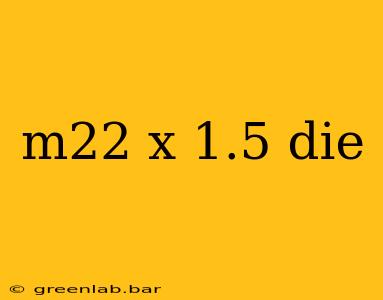Finding the right die for your threading needs can be challenging. This guide focuses specifically on the M22 x 1.5 die, providing detailed information to help you make informed decisions. We'll cover its specifications, applications, and selection criteria, ensuring you have the knowledge to choose the perfect die for your project.
Understanding M22 x 1.5 Die Specifications
The designation "M22 x 1.5" refers to the die's crucial dimensions:
- M: Indicates a metric thread.
- 22: Represents the nominal diameter of the thread in millimeters.
- 1.5: Specifies the pitch of the thread, meaning the distance between adjacent thread peaks in millimeters.
This means the M22 x 1.5 die creates external threads with a 22mm diameter and a 1.5mm pitch. Understanding these specifications is crucial for selecting the correct die for your specific application. Incorrect thread dimensions can lead to faulty connections and compromised structural integrity.
Applications of M22 x 1.5 Dies
M22 x 1.5 threads are commonly found in various industrial and mechanical applications where a strong, reliable connection is required. Some common uses include:
- Automotive Components: This thread size might be found in various automotive parts requiring robust and precise connections.
- Machinery and Equipment: Industrial machinery often uses M22 x 1.5 threads for fastening components that need to withstand significant stress.
- Hydraulic Systems: In hydraulic systems, the precise threading is essential for leak-free operation and maintaining system integrity.
- Manufacturing Processes: Precision threading is critical in numerous manufacturing processes where dimensional accuracy is paramount.
The wide range of applications highlights the versatility and importance of the M22 x 1.5 die in various industries.
Selecting the Right M22 x 1.5 Die
Choosing the appropriate M22 x 1.5 die involves considering several factors beyond just the thread dimensions:
- Material: Dies are made from different materials (high-speed steel, carbide, etc.) offering varying degrees of durability and lifespan. The material selection depends on the material being threaded and the anticipated workload.
- Die Type: Different die types exist (e.g., hand dies, machine dies, adjustable dies) each suited for different applications and methods of threading. Hand dies are suitable for smaller-scale projects and repairs, whereas machine dies are used for mass production.
- Thread Form: While the M22 x 1.5 standard generally implies a metric ISO 68-1 profile, confirming this is vital to ensure compatibility.
- Tolerance: The tolerance of the die dictates the precision of the threads it creates. Tighter tolerances lead to more precise threads, often necessary for critical applications.
Ignoring these factors can lead to inferior threads, potentially compromising the structural integrity and performance of the final assembly.
Maintenance and Care of M22 x 1.5 Dies
Proper maintenance extends the lifespan of your M22 x 1.5 die:
- Regular Cleaning: Remove metal chips and debris after each use to prevent clogging and damage.
- Lubrication: Using appropriate cutting fluids or lubricants during operation reduces friction and wear.
- Proper Storage: Store dies in a dry, clean environment to prevent corrosion and damage.
Following these simple steps significantly prolongs the life and effectiveness of your die.
Conclusion
The M22 x 1.5 die is a crucial tool in various industries, requiring careful selection and maintenance. Understanding its specifications, applications, and selection criteria allows professionals to ensure the quality and reliability of their threaded components. By considering the factors outlined in this guide, you can confidently choose the right die for your project, leading to efficient and successful threading operations.

